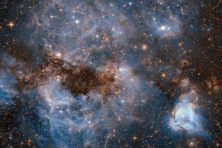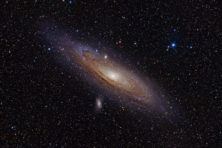Eye On the Night Sky: Seeing Stars Again
- Share
- Tweet
- Pin
- Share
by Jerod Santek, Write On, Door County Executive Director
On a crisp autumn evening, people gathered at the Roy and Ruthie Stonecipher Astronomy Center for “Stories Under the Stars,” presented by Write On, Door County in partnership with the Door Peninsula Astronomical Society (DPAS). The guest presenter was Robert Mathieu, Professor of Astronomy at the University of Wisconsin – Madison. Write On had planned the evening as a free family program, and both the organization and the presenter prepared for a group of children eager to hear the legends of the constellations, accompanied by their parents.
Instead, more than 30 adults faced Professor Mathieu – not a child in sight. While there were no children in sight, perhaps there were many inner children present, with adults as eager for the stories of the stars as the young people would have been. We never tire of stories, and the stars provide endless possibilities.
Professor Mathieu shared his love for the night sky and his fascination with how the universe works with the audience. His passion for his subject was infectious. He told the legends of the fall constellations, some familiar, others less so.
Cassiopeia, mother of Andromeda, declared herself to be the most beautiful woman in the world, more beautiful even than the gods. Poseidon and Zeus punished for her vanity by placing her in the sky upside down during the fall, when her constellation is best seen. Her husband, Cephus, was placed next to her, having to hear for all of time about her beauty.
In showing the constellations of Pegasus, Perseus, and Andromeda, Mathieu revealed that for 30 years he had been telling the story incorrectly that Perseus travelled on the winged horse to rescue Andromeda, who had been chained to a rock in the ocean as a sacrifice to the sea monster.
Mathieu also pointed out how some constellations don’t quite mirror our reality. The outline for the constellation Ursa Major, for instance, shows The Great Bear with a tail, resembling that of a beaver. Mathieu said he never thought much about it until one of his young students asked, “Why does the bear have a tail?”
Though most American students are familiar with the Greek legends of the constellations, every culture has a legend for the stars. Among Native Americans, a Blackfoot legend concerns a young woman with seven brothers and a little sister. In love with a bear, the older sister transformed herself into one and killed many in her village. The youngest brother eventually killed her and decided the family could no longer live on earth. They traveled together to the heavens, where the little brother became the North Star and his siblings form the rest of the Big Dipper.
There is still much we don’t know about the sky. In fact, Mathieu stated, what we do know is that we don’t understand 97 percent of the universe. For those of us who love stories, that’s good news. That gives us a lot of material for new stories!
“Eye On the Night Sky” is a monthly column by the Door Peninsula Astronomical Society. The Door Peninsula Astronomical Society meets the first Tuesday of the month. The Nov. 1 meeting will have “viewing target of the month” presented by David Udell and Dr. Beck will give a presentation on the Kuiper Belt and Ort Cloud. DPAS has a public viewing night scheduled at the Observatory on the evening of Nov. 5. For more information on the organization, visit DoorAstronomy.org.




